Nigel J. Ross
Travelogue

Our journey out to Marrakech on Thursday 23rd August couldn’t have been easier. Our AtlasBlue (Royal Air Maroc) plane left on time, arrived and time and we got through the Menara (Marrakech) airport quickly and easily. Outside the airport, however, we soon realised where we were, having to bargain hard to get a decent taxi price. Marina and I had three guidebooks to the city between us, each one telling us that the airport was a different distance from the city (5, 6 or 7 km). Whatever, it was a quick ride along the city walls, and then into the main square of Jemma el Fna, known to the locals as “la Place”. We were glad we had our wheelie cases as we made our way through a few narrow lanes off the square and to our hotel. We were staying at the Jnane Mogador hotel, an old riad (palatial home) with rooms around a highly-decorated central courtyard with its central fountain. Our ground floor room was fine, though rather small. It just took a bit of organization and co-ordination!
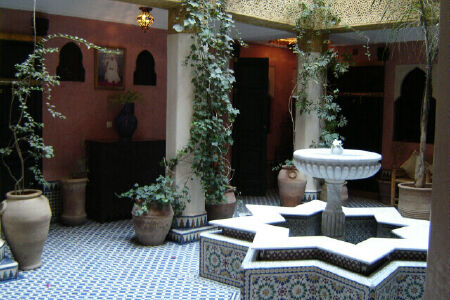 Marrakech, the Jnane Mogador hotel
Marrakech, the Jnane Mogador hotel
We quickly settled in a headed straight back to the Jemma el Fna square, the true heart of the city. And we dived straight into the souks (market alleys) which go off in a vast maze from the north of the square. The shops sell spices, textiles, leather goods, lanterns, slippers, jewellery and many other bits and pieces. Many of the lanes are covered with parallel slats of wood, giving a delightful shaded effect to the lanes below. Every so often they open out into a small square with stalls selling baskets, fruit and vegetables, and general wares. Mixed in the maze of shops and stalls are bars, pharmacies, food shops, banks and antique shops. After an hour of so, getting completely lost and overwhelmed by all the things on sale, we managed to find our way back to the main square and went up to the roof-top terrace of the Hotel CTM for a mint tea and an opportunity to watch the world go by. All of Marrakech seems to pass through the square, and we watched it all happen, fascinated, for a couple of hours. As the afternoon turned into early evening, vast numbers of special stalls, along with tables and benches, were wheeled into the square, and as the sun set, these make-shift restaurants began cooking, creating swirls of smoke in all corners of the square.
 Marrakech, Jemma el Fna
Marrakech, Jemma el Fna
It was time to go quickly back to the hotel, get changed and find somewhere for dinner. We went south to the Café el Badi, where again on another rooftop terrace, we had an excellent first Marrakech meal of vegetable soup, tajine (conical cooking pot) of vegetables, melon and watermelon, mint tea and biscuits. It was then back to our small and rather warm room for a good night’s sleep.
We were again on a rooftop terrace the next morning for breakfast. This time it was the hotel’s terrace, where it was surprisingly cool after the warm night. We sat in the tent on the rooftop for a bit of shelter, where we had our orange juice, milky coffee and heavy pancake with butter and honey. Half an hour on the hotel’s internet, to let everyone know we’d arrived safely, and we set out in the direction of where we’d had our meal the night before to see the El Badi palace, the magnificent ruins of the “Incomparable Palace” dating back 1000 years. Still today the vastness of the ruins gives some idea of how magnificent it must have been. The main courtyard contains vast pools with four sunken gardens each containing scores of orange trees. The ruins were good to explore, down to the underground passages, and up to a lookout tower, where we found ourselves on a level with the numerous storks and their nests perched on the tops of the ruined walls.
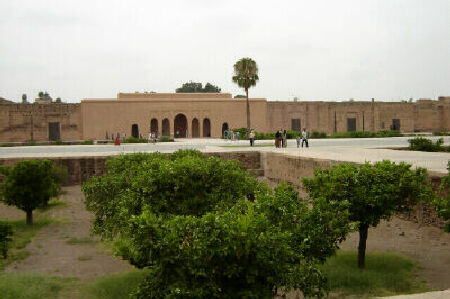 Marrakech, the ruined El Badi palace
Marrakech, the ruined El Badi palace
Before lunch we walked through part of the Mellah (the Jewish quarter) exploring its small souk and buying some key tassels. For lunch we had an omelette and vegetable tajine in an open-air café in the square.
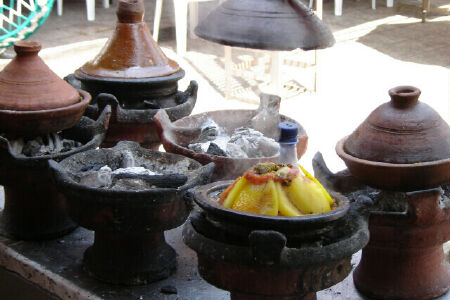 Marrakech, a vegetable tajine being cooked
Marrakech, a vegetable tajine being cooked
After a long relaxing coffee, we set off to see the Saadian tombs. Rather than taking the longer, but simpler route, we tried to find a way through the lanes, which involved us entering a shop from the front and going out the back way (without having to buy anything … not an easy task). Eventually we spotted the minaret of the Kasbah Mosque and knew we were close. With a hidden-away entrance, the tombs are an enormous secret mausoleum of the Saadian princes, ensconced behind very high walls. The elaborate stucco decoration of many of the tombs is quite exceptional.
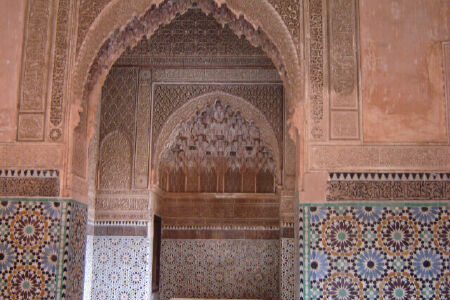 Marrakech, the Saadian tombs
Marrakech, the Saadian tombs
We took a slightly more circuitous, but easier route back, and then made our way to the El Badia palace. The El Badia palace is a vast complex of delightful tiled courtyards and richly-decorated rooms. Some of the courtyards also have small gardens and fountains, and the doorways in particular are spectacular in their elaborate stucco decoration. Unfortunately the palace is empty, but the decoration easily made up for lack of furniture.
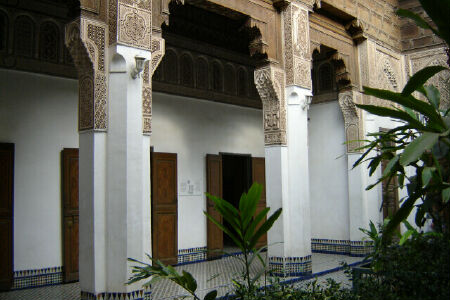 Marrakech, the El Badia palace
Marrakech, the El Badia palace
After our three very interesting visits, we slowly meandered back to the city’s main square. Just to the east of the square is the soaring minaret of the vast Koutoubia Mosque, which we went to have a closer look at.
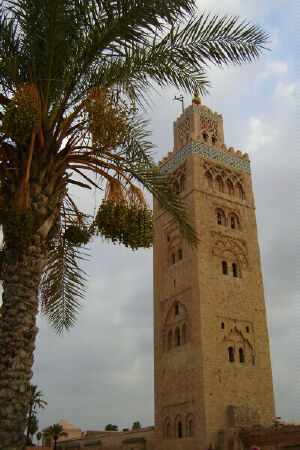 Marrakech, the tower of the Koutoubia Mosque
Marrakech, the tower of the Koutoubia Mosque
We needed a rest after all the walking, but a bit later we found the energy to go and have dinner at the Jama restaurant, eating our salad starter and couscous and vegetables in the quaint candle-lit courtyard for the very modest price of 170 dirham (around 17 euros for the two of us). A nightcap on the terrace of the Grand Balcon overlooking the main square rounded off the balmy evening.
On the Saturday morning we took ourselves off to the Toukbal bar in the main square for our breakfast where for less than a couple of euros each we had coffee, orange juice, croissants and crepes with honey. Before it got too hot, we walked along Avenue Mohammed V towards the Ville Nouveau (the new town, created by the French, outside the original city walls). We walked through the beautifully-kept Cyber Park and also looked in on the official handicraft store where we got good ideas of products and prices. The road to the new town was long and hot, but it was also an interesting walk. While the buildings were at times very modern and chic, the deep clay-like pinky-red colour of the city was maintained throughout, like a leitmotif. A long leisurely stop in a bar for a coffee was a necessity, and a few more shops and streets further on we found it was already lunchtime and we headed for a little pavement café-cum-restaurant were we had an ample lunch of Salade Nicoise. Just a bit further on and we got to our main destination of the day, the Majorelle Gardens.
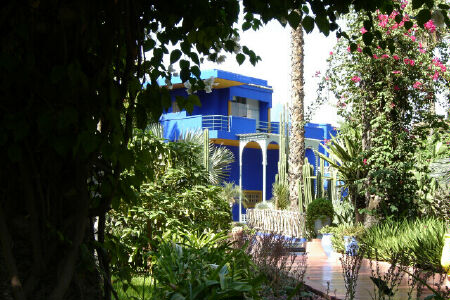
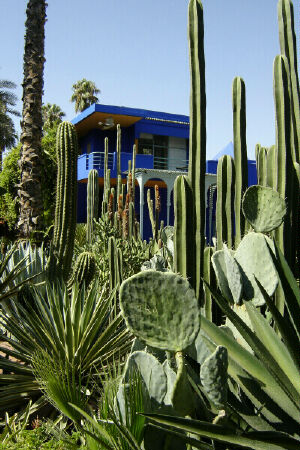 Majorelle Gardens
Majorelle Gardens
The Majorelle Gardens are truly enchanting. While they are not vast, they have a great variety of plants and garden areas, as well as various deep-cobalt buildings, tubs and other garden features. The main house is now Yves St Laurent’s Museum of Islamic Art and has some fascinating pieces. The variety of cactus, palms, succulents and other plants is incredible, and the pools, fountains, covered porticos and walkways make for a mini paradise after the concrete new town. There are many birds in the gardens, too, and in the end we had to really tear ourselves away from the place and face the bustle of the traffic in order to return to the medina. We took a fairly direct route back and even managed to walk through the souks without getting lost, though we did buy a couple of lanterns en route.
After a shower and a rest, we went to eat at the Alhambra terrace, overlooking the main square. Then after dinner we walked around the main square, watching the story-tellers, the acrobats, the instrumentalists and the fun-fair type games as well as the crowded open-air restaurants full of happy locals. We again got a bit lost in the alleys, but managed to find our way back to our hotel without too much difficulty.
We spent the Sunday in the medina. Again we had breakfast at the Toukbal bar, though it was much fuller than the previous day, and we concluded that a lot of locals were treating themselves to a Sunday breakfast in the main square. Walking through the souks – and getting rather lost this time, as we realised because we passed the same spot four times – we eventually emerged at the north-west corner and went to try and find a riad to book our last night’s stay in the city at the end of our holiday. We followed signs down narrow lanes to the Riad Julia, and were immediately enchanted. It was much lighter and airier than where we were staying, and the rooms were larger. The price was the same as the Jnane Mogador, the only drawback was that it was not so central, but ideally suited for our last night, being on the airport side of the centre. We were shown around by a rather dozy girl, who asked us to write out our own receipt for our advance payment for the 2nd September.
Back in the souks, we miraculously found our way directly to the Ben Youssef Medersa (the Koranic school). The Medersa has a fine courtyard, again with incredibly decorative elements, including elaborately carved cedar wood beams.
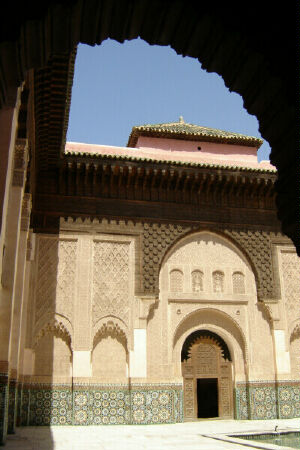
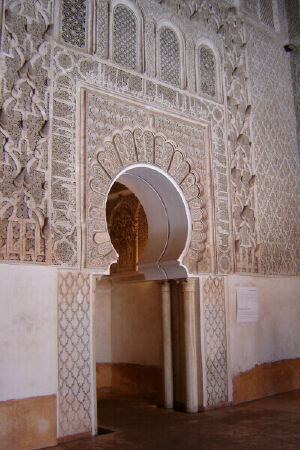 Ben Youssef Medersa
Ben Youssef Medersa
Next door we paid a visit to the Marrakech Museum (the Dar Mnebhi palace). The former kitchens were housing a temporary exhibition of papier maché “dresses” and pictures. But the main part, including the vast main covered courtyard, housed a fascinating range of southern Moroccan artefacts. Off the covered courtyard, narrow corridors led to the old hammam.
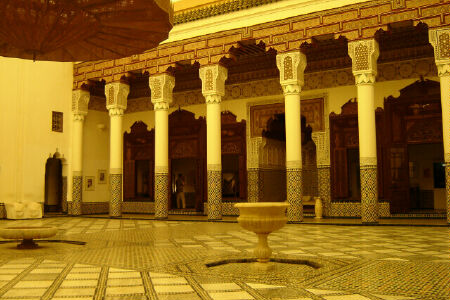 Marrakech, Dar Mnebhi Palace (Marrakech Museum)
Marrakech, Dar Mnebhi Palace (Marrakech Museum)
Close-by was our third main site to visit, the 12th century Kouba Ba’adyn, a very small, simple sanctuary with some original decorations in the middle of an archaeological site.
In the heat of the early afternoon sun, we bravely walked the length of Rue Bab Dabachi, spying on some of the tanneries, and having a good look at the Dabachi gate to the city, one of the least altered entrances to the old city. We then walked back to the souks to have a very late lunch (our large breakfast had stood us in good stead for such a long morning) and a much needed sit down. The end of the afternoon was spent back in the souks, making a few purchases. We also had a cup of Atlas mountain herb tea in the Bougainvillea Café in the souks.
 Marrakech, a typical lane in the pinky-red city
Marrakech, a typical lane in the pinky-red city
Our choice of restaurants for our evening meal took some real hunting down, and in the end we had to engage the services of a boy (and pay the tip). We wondered if the young local kids remove the signs to some of the lanes and restaurants to make some money from the bewildered tourists! But it was well worth finding the Tamsna Riad, despite the fact that it was at the end of a smelly dead-end lane. The restaurant area was in the open portico-ed courtyard of the majestically restored palace, and we had an excellent meal of olive and humus patés and baked tomatoes topped with crumbled cheeses for starters, followed by stuffed sardines with potato cakes for the main course, and a wicked “tutti-frutti” compote to finish off with. After the meal we were treated to a guided tour of the other floors: a large lounge area, an art exhibition, a shop selling local craft items and finally the very high terrace with fantastic views over the whole city.
Early the next morning, we set off from Marrakech to the mountains. We found a “grand taxi” in one of the corners of the grand place, and after haggling over the price, we set off for the High Atlas Mountains. At first the route was past stretches of desert interspersed with walled gardens and orchards full of lush vegetation, and often with a mansion at the centre. But slowly but surely, the mountains soon came into sight and we started the climb. The roads were good and it was an easy drive up to Setti Fatma (about 1 1/4 hours). We tried to explain to the driver that we needed to be dropped off at the Perle d’Ourika hotel, but he spoke hardly any French. So it was just as well we saw it at the roadside as we came into Setti Fatma and persuaded him to stop. And almost as soon as we stopped, we were being welcomed by our host, Ammaria, the owner of the Perle d’Ourika. Ammaria treated us so very well over the next few days … living up to our expectations after making a friendly phone booking from Italy (having eventually found the right phone number, since all the guidebooks again gave wrong numbers).
We were the only guests at the Perle d’Ourika (apart from Ammaria’s son and family), partly because Ammaria usually only takes a few guests (she only has five rooms), but also because she had no running water for the first day or so when we were there. She explained that the river in the valley below had changed its course very slightly, and this had caused her well to run dry. Machines were digging when we arrived, to deepen the well, and then a new pump be fitted the next day. Still she had got her helpers to fill hundreds of plastic bottles from the river to use for ablutions, and we managed very well for the first day.
Our spacious room (the only one with en suite facilities) was pleasant, but we were especially taken by the large patio above our room overlooking the valley and with views up to the high mountains. The rustic wooden furniture on the patio was enhanced with braids of coloured wool hanging here and there, and lots of coloured tajines perched rather precariously around the balustrade.
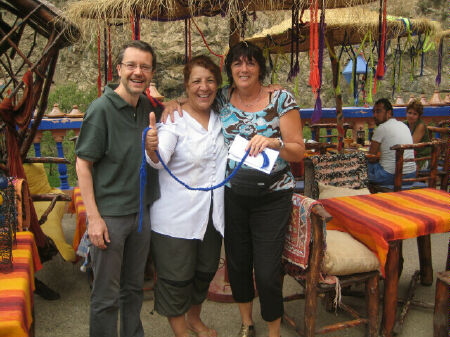 Setti Fatma (Atlas Mountains), at the Perle d'Ourika with Ammaria and Marina
Setti Fatma (Atlas Mountains), at the Perle d'Ourika with Ammaria and Marina
Late in the morning, we set off to explore the village of Setti Fatma, which is basically just one long street of houses, shops, hotels and café-restaurants along the river at the end of the road from Marrakech. We walked across a very rickety footbridge (the first of many) to a grassy area on the other side of the river where we could sit and have a coffee under some shady trees, courtesy of the Le Noyer restaurant. The place was delightful, and we sat and wrote our postcards and diaries, and found ourselves still there at lunchtime. We enjoyed a mushroom omelette with vegetables, but then felt we had to make the effort to see some more of the place. Walking further up the valley to a point where it opened out more and the village had something of a centre, we saw lots of improvised rickety bridges across the river (many of them get washed away when the river is in spate in early spring) leading to a large number of cafés and restaurants behind which the paths up to the waterfalls began.
 Setti Fatma, the Ourika valley
Setti Fatma, the Ourika valley
Although we didn’t really have the right walking shoes, we followed the very rocky path for about half an hour, arriving at a first smallish waterfall. We decided that that was enough for the day, and made our way back to the hotel ready for a relaxing sit on the breezy patio. Ammaria brought us her visitor’s book, and we were interested to read through the numerous very complimentary comments. We discovered that her daughter lives in London and works for British Airways, which in part explains Ammaria’s excellent English. She made us some verbena tea with herbs from her garden, and then she offered to make us a dried-fruit tajine with couscous for dinner that evening, which was exquisite, not only for the taste, but also for the setting, since it was served on the moonlit and candlelit patio on a truly balmy evening.
After breakfast on the patio, the next day (Tuesday 28th) we spent in and around Setti Fatma. Wearing our proper walking shoes, in the morning we walked up the very stony and slippery paths to see more of the waterfalls. In places this also involved clambering over rocks and crossing precariously placed makeshift bridges. Eventually we got to a particularly large waterfall, cascading down in a single drop to a large pool below. Lots of local boys (and girls, fully dressed) were diving into the pool. At one side there was a shady café where we had a long sit, watching the antics of the divers, the monkeys and snake charmers.

 Setti Fatma, the valley and waterfall
Setti Fatma, the valley and waterfall
Back down from the waterfall, we bought some water and fruit and found a shady spot on the side of the river and had a relaxing late picnic lunch. Later in the afternoon we wandered back to the hotel, crossing another very rickety bridge to have some mint tea at a café on the far side. And Ammaria that evening treated us to a superb dinner of salad entrée with crab, then lots of delicious fried fish. But after a beautifully warm, sunny day, we were surprised to hear the sound of a heavy downpour as we were going to bed. And the amount of water coming down was really incredible … it was running down the windows and even coming in through one of the windows in the bathroom at one stage. But as we were turning the lights out, it started to ease.
Breakfast the next day was one continuous laugh. I said good morning to Ammaria, adding that I was surprised it was such a glorious, sunny day. She looked a little perplexed as she served us some freshly-made cake for breakfast. She then explained that the night before the patio had flooded as the new pump her son had fitted in the extra-deep well had worked so well and it had filled the water tank to overflowing. We then put two and two together, realising that the rain of the night before had been the water running over the edge of the patio, and as our room was directly beneath it “poured” down our windows. Our three days at the Perle d’Ourika were indeed a story of water and laughs!
In very good spirits, we set off for a long walk into the mountains, to the Berber village of Tadrart. We started along the valley road, which quickly became an unmade road. We soon came up against a massive bulldozer which was remaking the road, and we quickly realised why. The unmade road followed the edge of the river, and had clearly been washed away in large stretches by the river in spate earlier in the year. It was incredible to see some roadside buildings perched on hardly anything, their foundations visible where the road had been swept away. The many broken stretches of road meant we had to do as the locals were doing and walk along the rocky river bed, hopping across stepping stones at many points. This first couple of kilometres took much longer than expected, and we were ready for a sit down when we reached a shady bar and before we started to climb uphill. After our rest and after watching the comings and goings from a Berber village on the other side of the river, some locals helpfully pointed us in the right direction.
 The Ourika valley
The Ourika valley
It was a steep uphill track at first, but after a few hundred metres we bore left as the locals had told us, and then the track more or less followed the contours of the hills for the next seven kilometres, gradually gaining height. So without any shade, we followed the track, perched half-way up the valley side, for a couple of hours. We encountered occasional men, women and children, some on donkeys, some walking. Often the donkeys were laden with all sorts of goods. The views up and down the valley gradually became much more interesting as we began to see the head of the valley and the high peaks in both directions.
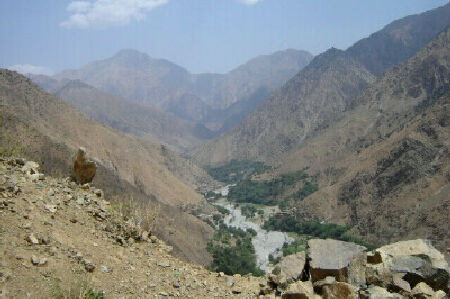 The Atlas Mountains (Ourika Valley)
The Atlas Mountains (Ourika Valley)
Everywhere was very barren, with just a few scrubby bushes and occasional thistles. However, every so often near to the tiniest almost dried-up stream, there were patches of very carefully-tended green terracing, generally growing crops, vegetables or fruit trees. It was hot under the midday sun, and our supply of water was only rather limited. We kept on hoping that the Berber village we were heading for would soon appear round the next bend, but it never seemed to. We got to the very last wide bend, and promised ourselves that if it wasn’t round the next corner, we would turn back, our water reserves already being very low. But there in front of us was Tadrart.
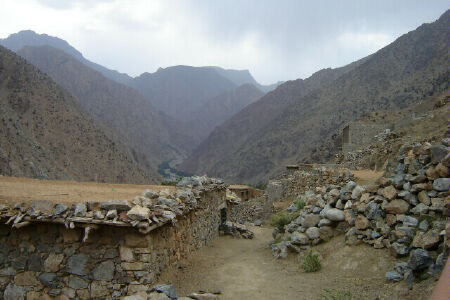 Tadrart, Berber village in the Atlas Mountains
Tadrart, Berber village in the Atlas Mountains
It was just a clump of small flat-roofed mud houses and at first seemed to be totally uninhabited. We saw one woman at a window and slowly approach her house as she came out in traditional dress. She invited us to eat: “Manger?” We tried to explain that we only needed water, but she didn’t understand. Other women appeared, then a couple of men and some children. As we entered the village, we were soon surrounded by people, the women and men mainly in traditional costume, the children in more western clothes. We tried speaking in French to no avail; we used our Arabic phrasebook, again with little success. Then with a mixture of gestures and a couple of Berber words from the back of the guidebook, one man seemed to understand and took our water bottles away. As we waited for the return of the water bottles, we started to give some of the younger children some pens and other things we had with us. This created problems as no way did we have enough for all of them, and there were scuffles between the children as they fought over our presents. When our water bottles came back, we realised we needed to make a quick retreat as some of the kids were trying to get into our backpacks.
Although we could have done with a good rest, we set off back to Setti at quite a pace. We were followed for quite a distance by a small group of boys, insistently asking for pens, gifts, money or anything else they could think of. Keeping up a good pace, most of them gradually dropped behind. Eventually we were left with two very insistent boys, and we dug deep into our backpacks for two last pens. With our water, and with one or two clouds that had miraculously appeared to give us some shade, the walk back, gradually downhill, was not so strenuous. We stopped off again at the shady bar on the river bank and had a Sprite sitting under a tree while a few drops of rain came down. But it was just a very short shower, and we were soon off to Setti Fatma along the river bed. In Setti we stopped at another shady riverside café for a welcome glass of mint tea, before heading back to the Perle. Ammaria had prepared a big bowl of pasta in our honour that last evening, and was amazed to hear of our long, 18 kilometre trek up to Tadrart.
The next day we were sorry to be having our last breakfast on Ammaria’s pario, but we were pleased to be offered a lift with her son and daughter-in-law and their two children to Marrakech. They were on their way back to Casablanca, but the route took them through the city. We were entertained on the journey by the four-year-old Maria. We were dropped at the Supratours bus station, only to find we had missed the coach to Essouira by 30 minutes and would have to wait nearly four hours for the next one. At the “grand taxi” rank, we haggled and eventually got a taxi that would take us to Essouira for 500 dirham. The two-and-a-half hour journey across the desert was long and hot. After leaving the city environs, we went through occasional towns and scattered olive groves, but most of the route it was very barren, and hot and sticky in the back of the taxi; as we neared Essouira, however, scrubby growth again appeared, mainly of very dusty thuya trees. And then we got to the town and the ocean.
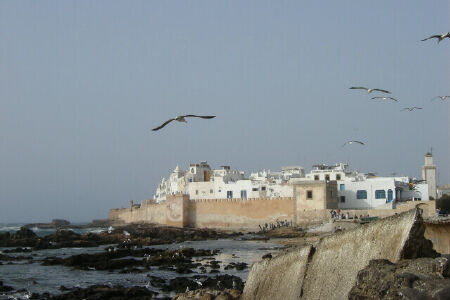 Essouira
Essouira
The taxi driver dropped us at a convenient point so that we could trundle our cases through the narrow cobbled streets straight to our hotel: the Dar al Bahar. Our room was a very pleasant neat and stylish triple with whitewashed walls and blue doors and window frames, just like the outsides of all the buildings here. We showered after the sweaty journey and then went out to explore the town. Essouira is completely walled warren of alleys. The high ramparts on the seaward side denote its prominent, defensive position, defending against an angry ocean as well as past invaders. It was a lot cooler in Essouira, not least because of the sea breeze.
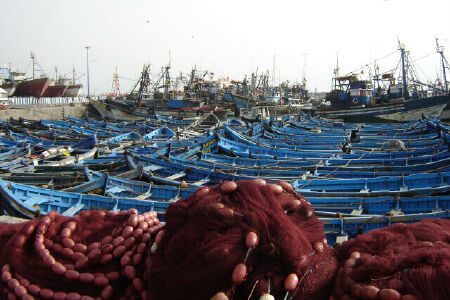 Essouira, the fishing port
Essouira, the fishing port
We had a good long walk around the quaint port and part of the old town; the white-and-blue of the place being a pleasant contrast to the red of Marrakech. Our evening meal that first night was at the very good Alizé restaurant: after a salad starter we enjoyed a sardine tajine (though we had to ask the waiter to confirm that what looked like meat balls were in fact sardine boulettes). An after-dinner stroll through the brightly-lit old town was great fun, even if we did venture into the less salubrious and less touristy Mellah area.
Friday 31st August was a no-no day for me. I’d been ill during the night and stayed in bed most of the day. Perhaps it had been the very hot ride across the desert the day before, of perhaps it was the effect of the water we’d been given in the Berber village. I occasionally woke up to the sound of passing marching groups of clapping, shouting political activists, trying to drum up support for forthcoming elections, but otherwise I just slept it off. Poor Marina had to look after herself, but she did so without problems, even having a massage.
I woke up the next morning feeling heaps better. We breakfasted on the top-floor terrace with views down to the rocky coast below, across the rooftops of the town, and up to the seagulls drifting gracefully above our heads.
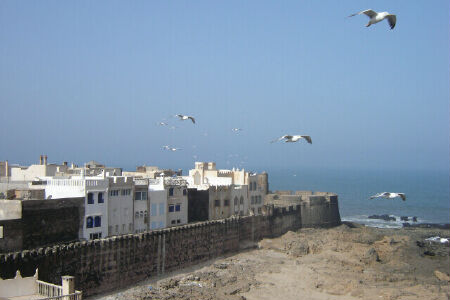 Essouira, the coastline seen from the hotel terrace
Essouira, the coastline seen from the hotel terrace
We first walked to the ramparts of the Skala de la ville for excellent views and a look at the well-fortified battlements with rows of canons.
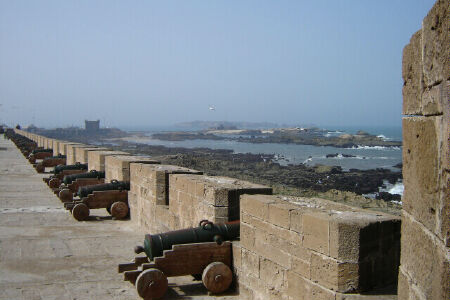 Essouira, Skala de la ville
Essouira, Skala de la ville
The city’s small museum is a fine old building, and some of the objects on display, especially the old carpets and costumes were interesting. After a stop for coffee, we walked a few kilometres along the broad beach to the very ruined castle on a small rocky outcrop. It was an excellent stroll, between locals playing football and others doing the walk, or doing it the easy way on camel back. It was low tide, so there was no problem crossing the mouth of the small river just before the castle. Near the castle, we walked into the dunes and lay in the dip of the sand, having a bit of a rest out of the sea breeze. As we returned, we saw the castle was already cut off by the rising tide, but there were no problems crossing the river mouth.
 Essouira, the beach and remains of fortress
Essouira, the beach and remains of fortress
We were back into the town by 2 o’clock, in time for a late lunch. We went back to the hotel to get the fine sand out of our clothes and hair, and then went first of all to find out about times of coaches for our trip back to Marrakech. We tried both Supratours and the other coach companies, but we discovered that all seats were taken for the next day, unless we wanted to travel on very rickety old buses. When I asked at the office if the coaches had air conditioning, the ticket seller smiled and said there was only “natural breeze”. Next door to the bus station was the “grand taxi” rank, and after a lot of hard haggling, we eventually managed to book a taxi for the next morning from a convenient city gate.
Back in the town, we visited the few last parts we hadn’t seen: the spice market and the fish market, as well as the very quaint jewellery souk.
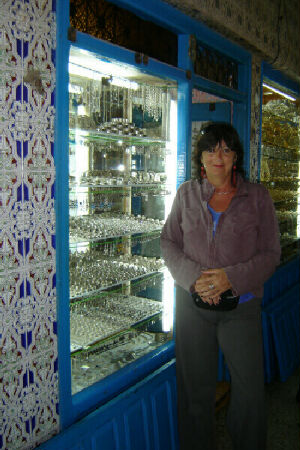 Essouira, the jewellery souk with Marina
Essouira, the jewellery souk with Marina
We bought some souvenirs, including thuya wood trays and other items. Our final dinner in Essouira obviously had to be in the port area, at the Chez Sam fish restaurant, where we had a tasty fish soup to start with, followed by some calamari in tajine and chocolate mousse.
There was a sea fog when we woke on the Sunday, but by breakfast time the sun was out and we could have our last breakfast in Essouira on the terrace: coffee, freshly-squeezed orange juice, croissants, as well as bread, butter and jam, all ordered via the intercom phone from the terrace to the kitchen on the ground floor and brought up the five floors by the waitress. And then we left the hotel, found our taxi and drove back through the desert to Marrakech. We got to the Riad Julia hotel by around noon. We had a mint tea in the courtyard while the maid finished preparing our room, and then we set off again into the city’s souks.
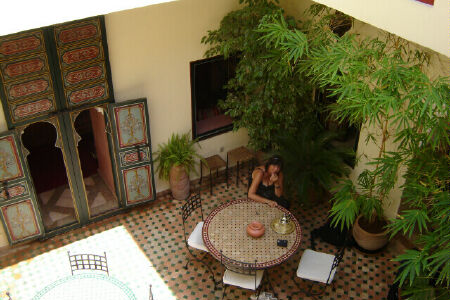 Marrakech, the Riad Julia
Marrakech, the Riad Julia
We had a sandwich lunch at the Café d’épice and then walked across town to the Dar al Said palace, the only major sight we hadn’t visited during our early stay in Marrakech. This palace was a bit disappointing, mainly because it was rather run-down. Especially on the ground floor it was full of rather dusty uninteresting exhibits. The central courtyard was, however, more attractive, as were the formal rooms on the first floor. Before leaving, a custodian was very eager to let us see some of the closed-off parts of the museum, for a small tip. The area had originally been used as the pasha’s harem, and was fairly interesting, but completely empty and in dire need of repair.
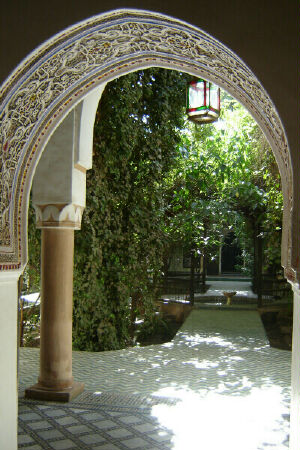 Marrakech, the courtyard of the Dar al Said palace
Marrakech, the courtyard of the Dar al Said palace
Back in the main square, we had a bitter lemon and then headed off for our few last bargains. By the time we’d got lost a few times in the souks, haggled over purchases of mirrors, slippers, a leather pouf, spices and much more besides, we were exhausted and laden when we got back to the Riad Julia. After relaxing by the courtyard pool in the hotel, we went out to book a taxi for 5:30 the next morning and to find somewhere to eat dinner. We settled on a not very posh restaurant where we ate well for a very cheap price, and it was conveniently close to the hotel! We set our alarms for 4:45, lazed a little while by the pool and went to bed reasonably early.
And everything went like clockwork the next morning … but it was back to Milan just after lunch, and back to work in the afternoon!
Home |
Publications |
Dictionaries |
English Lang. |
Art Insights |
Travel |
Links | ||||||